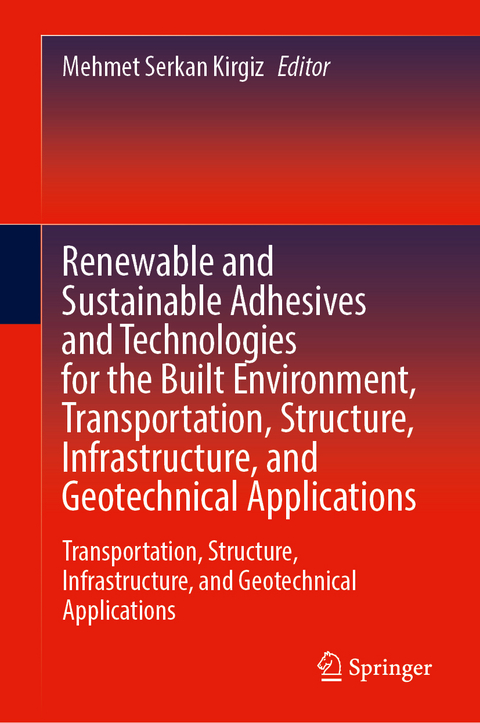
Renewable and Sustainable Adhesives and Technologies for the Built Environment
Springer International Publishing (Verlag)
978-3-031-56567-0 (ISBN)
- Titel wird leider nicht erscheinen
- Artikel merken
-Potential biodegradable materials for binder and binder-based materials,
-Effect of biodegradable materials on fresh and hydration of construction materials,
-Strength gain in hardened formaldehyde-free binder based materials containing biodegradable binder,
-Durability of formaldehyde-free binder based materials,
-Inner-structure analysis of formaldehyde-free binder based materials.
Dr. Mehmet Serkan Kirgiz is a Professor at Istanbul Sabahattin Zaim University. He has previously worked as full professor at various universities in Turkey, UK, Algeria, Nigeria, and USA. He began his professional experience, including teaching in the undergraduate, graduate and post-graduate level, research and development with TUBITAK (Scientific and Technological Research Council of Türkiye) and international institutions and universities collaboratively, and advising for students in their theses, in 1998. He also served as Dean, Member of Engineering/Architecture Faculty Management Board and Member of Civil Engineering/Architecture Department Management Board in the faculty of engineering and architecture from 1998 years to present. He is author of 260 peer-reviewed articles and pending-publishing articles along with books 6 and book chapters 37 published in highly reputable SCI journals and Scopus-based publishers. He holds a national patent on cement manufacturing through the burning of marble powder and brick powder as farina. His teaching interests include Structural Mechanics, Advanced Engineering Analysis, and Plasticity in Steel Structures. His research interests are within the broad fields of the ecology-based construction materials, minerals of raw and by-product material, and development of formaldehyde-free binder for construction materials and nanotechnology.
Chapter 1. Starch based compound for eco-friendly and sustainable construction adhesive and binder system.- Chapter 2. Self-compacting composite containing mine tailing and fortified by nanocarbon dot for manufacturing of cost-effective and CO2-neutral material in construction and infrastructure.- Chapter 3. Valorization of nano carbon dot based green binder systems in terms of earthquake engineering, reinforced concrete building, applied mechanics, transportation engineering, and their applications.- Chapter 4. Some technological properties of hydraulic construction lime and grouting incorporated with carbon nano tube fiber chopped for manufacturing of cost-effective and CO2-neutral material in cleaner built environment.- Chapter 5: Transforming oil sand waste ash into construction material using net-zero energy.- Chapter6. Properties of biodegradable fiber-incorporated-grouting retrofitted by graphene mac carbon nanomaterial for cleaner built environment.- Chapter 7. Ecological-sustainable-green brick material: unfired manufacturing system, some features, and usage for greener built environment and construction technology.- Chapter 8: Potential use of recycled concrete aggregate and recycled asphalt pavement aggregate in the silica fume-incorporated-roller compacted concrete strengthened by carbon nanograin.- Chapter 9: High-performance concrete made of seawater and cured in seawater to evaluate hydration composition and porosity with analysis of SEM, petrography, and mercury porosimetry in the lack of fresh water of cleaner built environment.- Chapter 10: Portland cement and starch-based adhesives: a comprehensive review.- Chapter 11: Additive for sustainable adhesive material- properties of eggshell additive and its application in construction and nanotechnology.- Chapter 12: Behavior of Bacterial Strain over Cementless Geopolymer Concrete for Sustainable Development.- Chapter 13: Geopolymer Bricks using Industrial Wastes to reduce CO2 Foot print.- Chapter 14: Natural rubber latex-substituted-bitumen binder for road construction -a review.- Chapter 15: Agro-industrial supplementary cementitious materials for realizing Sustainable Development Goals of UN and net-zero CO2 emission.- Chapter 16: Natural rubber latex and its effects on some properties of bitumen for cleaner built environment.- Chapter 17: Analysis of E-waste Containing Carbon and other Component as Composite Material for Cleaner Built Environment and Realizing Sustainable Development Goals of UN.
| Erscheint lt. Verlag | 23.7.2024 |
|---|---|
| Zusatzinfo | Approx. 350 p. |
| Verlagsort | Cham |
| Sprache | englisch |
| Maße | 155 x 235 mm |
| Themenwelt | Technik ► Elektrotechnik / Energietechnik |
| Technik ► Umwelttechnik / Biotechnologie | |
| Schlagworte | composite rotary desiccant wheels • composite rotary desiccant wheels • dehumidifier • indoor air quality • parabolic trough solar collector • Solar energy |
| ISBN-10 | 3-031-56567-3 / 3031565673 |
| ISBN-13 | 978-3-031-56567-0 / 9783031565670 |
| Zustand | Neuware |
| Haben Sie eine Frage zum Produkt? |
aus dem Bereich


